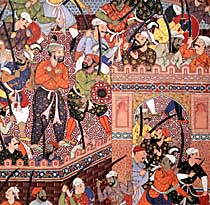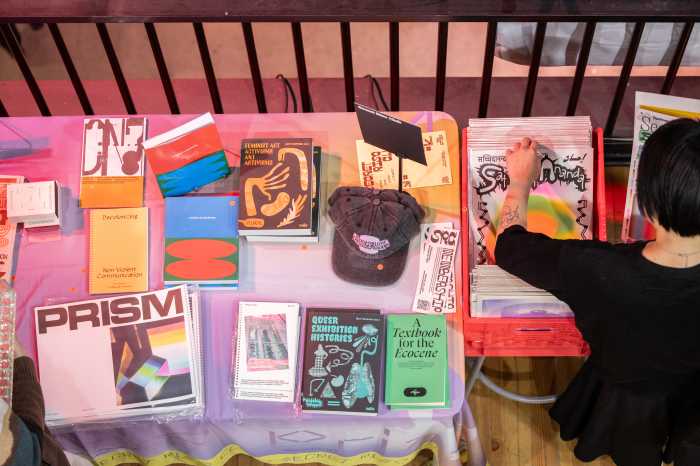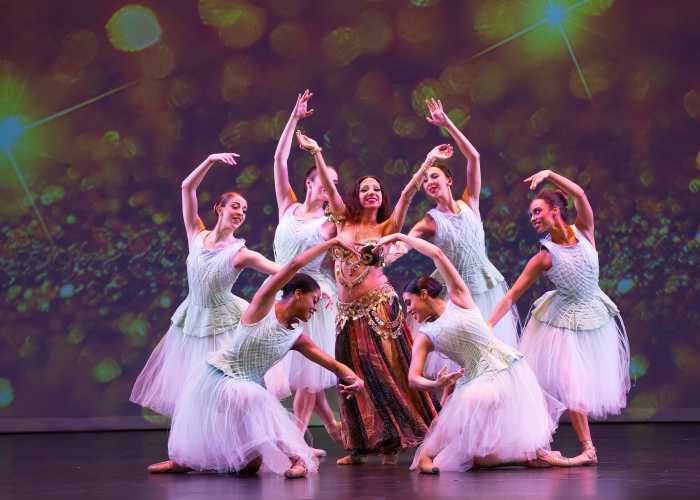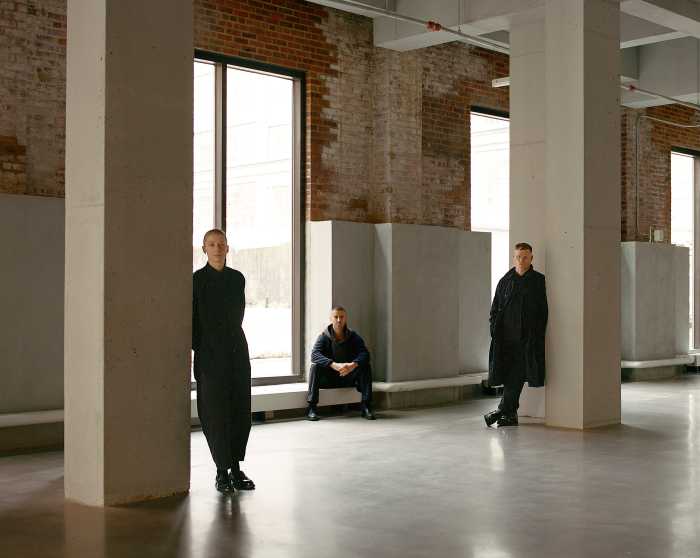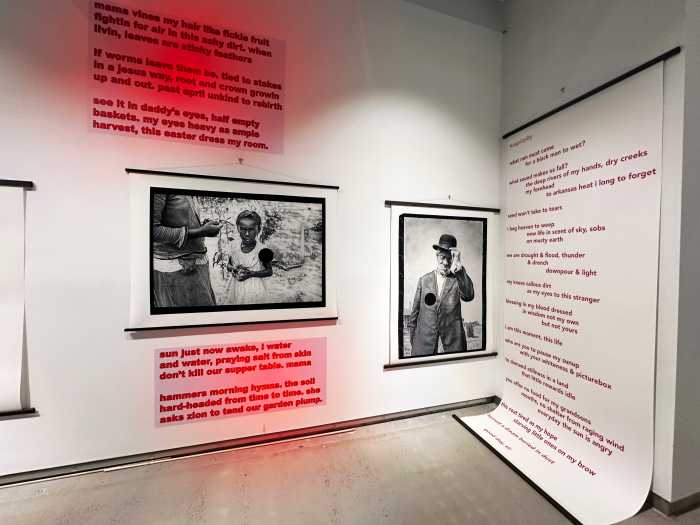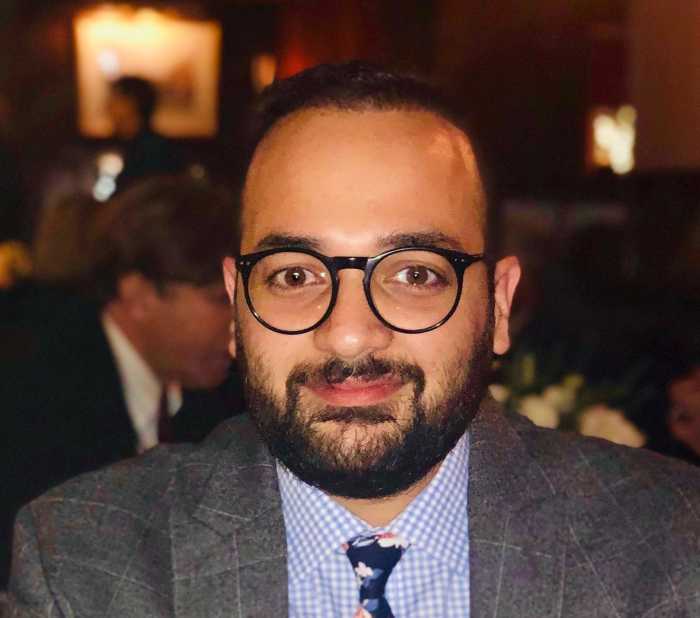Need a respite from ordinary, Western art?
Then get a dose of color therapy from the Brooklyn Museum of
Art’s current exhibition, "The Adventures of Hamza."
The 16th-century paintings serve to illustrate the epic Persian
tales about Amir Hamza, the paternal uncle of the Prophet Muhammad,
who traveled the world spreading the teachings of Islam.
While there doesn’t seem to be much represented in these illustrations
– brimming with lush, jewel-like colors and intricate patterns
– that overtly addresses religious subject matter, there is much
that deals with Hamza’s heroic adventures. With Ashqar, his three-eyed
horse, Hamza travels through Greece, the Caucasus, India, Ceylon
and Abyssinia.
In dense compositions, Hamza and his allies wage battle with
a fantastic array of fearsome "infidels and enemies,"
not to mention creatures like dragons, sea monsters, demons and
giants. In "Umar Slays a Dragon with Naphtha," attributed
to the artists Dasavanta and Tara, the white, serpentine dragon
with leopard-like speckles is wreathed in golden flames, his
mouth of large, sharp teeth open in a roar of pain. In contrast,
the tiny townspeople cower in safety at the top of the frame,
while Umar, in gilded clothing, takes on the dragon alone.
And the bloodshed! Battles take place in onion-domed castles,
in lavish, lush gardens and on ships with dragons’ heads carved
on their prows. The soldiers go to battle on an elaborately attired
array of rhinoceroses, camels, lions, tigers, wolves, elephants
and horses.
Hamza’s teeming armies go to war with swords raised high. The
bloody violence and gruesome dismemberment on the battlefield
is graphically represented in several paintings. One character,
Marku Boar-Tooth, meets his horrific end at the hands of a veiled
youth in a composition by artists Mukhlis and Lalu. Boar-Tooth
is sliced right down the middle by a sword – his corpse flopping
to either side like the peel coming off a banana.
Even Khosh-Khiram, a female spy, or ayyar, helps the good guys
by beheading the spy Kajdast. While for the most part, the female
figures in the illustrations are literally in the periphery of
the action, in this painting (attributed to artists Basavana
and Mukhlis), the woman is painted into the foreground, her crimson
red skirt drawing the viewer’s attention. The woman gruesomely
holds by the hair the head of Kajdast and in her other hand,
a small knife.
Khosh-Khiram’s solo victory is made more prominent by the artists
painting her against a backdrop of leafy green trees and grass,
rather than the usual riot of colorful soldiers and intricately
patterned textiles. Her victim’s headless corpse lies unceremoniously
splayed in the lower right-hand corner, with his shoes knocked
off.
These illustrations for the Hamza epic can be appreciated on
two levels: for the story itself, for which these 2-foot-tall
paintings were meant to be displayed while a storyteller recounted
the tales (the museum translates the text next to each work);
and or for the skilled craftsmanship, right down to the mesmerizing
miniature detailing of intricate patterns and lavish ornamentation
on buildings, carpets, canopies and clothing.
New York Times critic Roberta Smith described these paintings,
with their varying perspectives and crowded compositions, to
being "dense as collage."
"The Adventures of Hamza" is a spectacular array of
ornamentation, entertaining action and adventure, and painterly
prowess, befitting an emperor, especially a young emperor who
enjoys a good yarn. The illustrations were commissioned by the
Mughal Emperor Akbar, while still a teenager. (Akbar ruled much
of what is now northern India from 1556-1605.) Between 1557 and
1572, his atelier of Persian and Hindu artists fulfilled his
commission. "The Adventures of Hamza" exhibition reunites
more than 50 folios from their mammoth illustrated manuscript
called the "Hamzanama." (Only 200 survive from an original
set of 1,400.)
"The Adventures of Hamza" is organized by the Arthur
M. Sackler Gallery of the Smithsonian Institution, in Washington,
D.C. The principal lender to the exhibit, Vienna’s MAK (the Austrian
Museum of Applied Arts/Contemporary Art), with the world’s largest
holding of "Hamzanama" paintings, has lent a core group
of 28 paintings.
Four superbly preserved paintings from this show come from the
Brooklyn Museum’s own collection, including "Arghan Div
Brings the Chest of Armor to Hamza," "Zumurrud Shah
Reaches the Foot of a Huge Mountain and is Joined by Ra’im Blood-Drinker
and Yaqut Shining-Ruby," "Umar, Disguised as Mazmahil
the Surgeon, Practices Quackery on the Sorcerers of Antali"
and "The Ayyars, Led by Songhur Balkhi and Lulu the Spy,
Slit the Throats of the Prison Guards and Free Sa’id Farrukh-Nizhad."
The museum enhances the appreciation for the Mughal artisans
by displaying the ingredients of their resourceful palette. They
wrought their jewel-like paintings from lapis lazuli, indigo,
cinnabar (natural vermillion), red lead, ocher and verdigris.
There is also a poster in the exhibition identifying the cast
of characters – with illustrations, a sort of Playbill – so the
viewer can more easily "read" the stories in the paintings.
For those unable to see the exhibit before it closes on Jan.
26, the exhibit’s curator John Seyller, professor of art history
at the University of Vermont, has also assembled an informative
catalogue of the show (Azimuth Editions, 2002).
In the catalogue, Antoinette Owen, senior paper conservator at
the Brooklyn Museum, authors an essay on the complicated, technical
aspects of the paintings. Owen explains that the "Hamzanama"
illustrations are painted on fabric, while the stories were written
in calligraphy on paper and attached to the reverse side of the
illustrations. Supportive layers were included in between the
paintings and calligraphy, and elaborate margins were added.
After its visit in Brooklyn, "The Adventures of Hamza"
will be off to the Royal Academy of Art in London from March
15 through June 8.
"The Adventures of Hamza"
will be on display at the Brooklyn Museum of Art (200 Eastern
Parkway) through Jan. 26. Admission is $6, $3 older adults and
students with ID, free to children under 12 accompanied by an
adult.
On Jan. 26 at 3 pm, members of the Brooklyn Philharmonic Orchestra
will perform music from Persia to Kashmir, heard through Western
composers’ ears. Tickets to the concert, which include museum
admission and a gallery talk on the exhibit at 2 pm, are $15.
Tickets can be purchased in advance at the admissions desk, or
by calling (718) 822-5838.
For more information about "The Adventures of Hamza,"
call (718) 638-5000.


